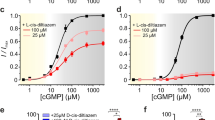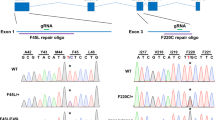Abstract
Retinitis pigmentosa is an inherited degenerative disease of photoreceptors leading to blindness. A well-characterized model for this disease is provided by the retinal degeneration mouse, in which the gene for the rod cGMP phosphodiesterase is mutated, as in some affected human families. We report that D-cis-diltiazem, a calcium-channel blocker that also acts at light-sensitive cGMP-gated channels, rescued photoreceptors and preserved visual function in the retinal degeneration mouse. The long record of diltiazem prescription in cardiology should facilitate the design of clinical trials for some forms of retinitis pigmentosa.
This is a preview of subscription content, access via your institution
Access options
Subscribe to this journal
Receive 12 print issues and online access
$209.00 per year
only $17.42 per issue
Buy this article
- Purchase on Springer Link
- Instant access to full article PDF
Prices may be subject to local taxes which are calculated during checkout





Similar content being viewed by others
References
Berson, E.L. Retinitis pigmentosa: Unfolding its mystery. Proc. Natl Acad. Sci. USA 93, 4526–4528 (1996).
Berson, E.L. et al. A randomized trial of vitamin A and vitamin E supplementation for retinitis pigmentosa. Arch. Ophthalmol. 111, 761–772 (1993).
Bennett J. et al. Photoreceptor cell rescue in retinal degeneration (rd) mice by in vitro gene therapy. Nature Med. 2, 649–654 (1996).
LaVail, M.M. et al. Protection of mouse photoreceptors by survival factors in retinal degenerations. Invest. Ophthal. Vis. Sci. 39, 592–602 (1998).
Silverman, M.S. & Hughes, S.E. Tranplantation of photoreceptors to light-damaged retinas. Invest. Ophththalmol. Vis. Sci. 30, 1684–1690 (1989).
Gouras, P., Du, J., Kjeldbye, H., Yamamoto, S. & Zack, D.J. Long-term photoreceptor transplants in dystrophic and normal mouse retina. Invest. Ophthalmol. Vis. Sci. 35, 3145–3153 (1994).
Farber, D.B., Flannery, J.G. & Bowes-Rickman, C. in Progress in Retinal and Eye Research vol. 13 (eds. Osborne, N.N. & Chader, G.J.) 31–62 (Pergamon, Oxford, 1994).
Bowes, C., Li, T., Danciger, M., Baxter, L.C., Applebury, M.L. & Farber, D. Retinal degeneration in the rd mouse is caused by a defect in the β-subunit of rod cGMP-phosphodiesterase. Nature 347, 677–680 (1990).
McLaughlin, M.E., Sandberg, M.A., Berson, E.L. & Drya, T.P. Recessive mutations in the gene encoding the β-subunit of rod phosphodiesterase in patients with retinitis pigmentosa. Nature Genet. 4, 130–133 (1993).
Farber, D.B. & Lolley, R. N. Cyclic guanosine monophosphate : Elevation in degenerating photoreceptor cells of the C3H mouse retina. Science 186, 449–451 (1974).
Lolley, R.N., Farber, D.B., Rayborn, M.E. & Hollyfield, J.G. Cyclic GMP accumulation causes degeneration of photoreceptor cells: simulation of an inherited disease. Science 196, 664–666 (1977).
Ulshafer, R.J., Garcia, C.A. & Hollyfield, J.G. Sensitivity of photoreceptors to elevated levels of cGMP in the human retina. Invest. Ophthalmol. Vis. Sci. 19, 1326–1241 (1980).
Cobbs, W.H. & Pugh, E.N. Jr. Cyclic GMP can increase rod outer-segment light sensitive current 10-fold without delay of excitation. Nature 313, 585–587 (1985).
Fesenko, E.E., Kolesnikov, S.S. & Lyubarsky, A.L. Induction by cyclic GMP of a cationic conductance in plasma membrane of retinal rod outer segment. Nature 313, 310–313 (1985).
Lee, K.S. & Tsien, R.W. Mechanism of calcium channel blockade by verapamil, D600, diltiazem and nitrendipine in single dialysed heart cells. Nature 302, 790–794 (1983).
Koch, K.W. & Kaupp, U.B. Cyclic GMP directly regulates a cationic conductance in membranes of bovine rods by a cooperative mechanism. J. Biol. Chem. 260, 6788–6800 (1985).
Noell, W.K. Differentiation, metabolic organization, and viability of the visual cells. Arch. Ophthal. 60, 702–731 (1958).
Sahly, I. et al. Calcium channel blockers inhibit retinal degeneration in the retinal-degeneration-B mutant of Drosophila. Proc. Natl Acad. Sci. USA 89, 435–439 (1992).
Stern, J.H., Kaupp, U.B. & MacLeish, P.R. Control of the light regulated current in rod photoreceptors by cyclic GMP, calcium, and l-cis-diltiazem. Proc. Natl Acad. Sci. USA 83, 1163–1167 (1986).
Schmitz, Y. & Witkovsky, P. Dependence of photoreceptor glutamate release on a dihydropyridine-sensitive calcium channel. Neuroscience 78, 1209–1216 (1997).
Buckley, M.M.T., Grant, S.M., Goa, K.L., McTavish, D. & Sorkin, E.M. Diltiazem A reappraisal of its pharmacological properties and therapeutic use. Drugs 39, 757–806 (1990).
Peachley, N.S., Goto, Y., Al-Ubaidi, M.R. & Naash, M.I. Properties of the mouse cone-mediated electroretinogram during light adaptation. Neurosci. Lett. 162, 9–11 (1993).
Mohand-Said, S. et al. Photoreceptor transplants increase host cone survival in the retinal degeneration (rd) mouse. Ophthalmic Res. 29, 290–297 (1997).
Mohand-Said, S. et al. Normal retina releases a diffusible factor stimulating cone survival in the retinal degeneration mouse. Proc. Natl. Acad. Sci. USA 95, 8357–8362 (1998).
Yu, W. P., Grunwald, M. & Yau, K. W. Molecular cloning, functional expression and chromosomal localization of a human homolog of the cyclic nucleotide-gated ion channel of retinal cone photoreceptors. FEBS Lett. 393, 211–215 (1996).
Harman, J.G., Limbird, L.E., Molinoff, P.B., Ruddon, R.W. & Gilman, A.G. in Goodman & Gilman's Pharmacological Basis of Therapeutics 9th edn. (MacGraw–Hill, New York, 1996).
Budavari, S., O'Neil M.J., Smith A., Heckelman, P.E. & Kinneary, J.F. in The Merck Index 12th edn. 451(Merck, Whitehouse Station, New Jersey, 1996).
Hicks, D. & Molday, R.S. Differential immunogold-dextran labeling of bovine and frog rod and cone cells using monoclonal antibodies against bovine rhodopsin. Exp. Eye Res. 42, 55–71 (1986).
Acknowledgements
We thank D. Hicks for suggestions and P. Bos and R. Bury for technical assistance. This work was supported by Fédération des Aveugles de France, AFRP/retina-France, ADRET-Alsace and Fondation de l'Avenir and Hopitaux Universitaires de Strasbourg.
Author information
Authors and Affiliations
Corresponding author
Rights and permissions
About this article
Cite this article
Frasson, M., Sahel, J., Fabre, M. et al. Retinitis pigmentosa: rod photoreceptor rescue by a calcium-channel blocker in the rd mouse. Nat Med 5, 1183–1187 (1999). https://doi.org/10.1038/13508
Received:
Accepted:
Issue Date:
DOI: https://doi.org/10.1038/13508
This article is cited by
-
T-type voltage-gated channels, Na+/Ca2+-exchanger, and calpain-2 promote photoreceptor cell death in inherited retinal degeneration
Cell Communication and Signaling (2024)
-
Redefining the role of Ca2+-permeable channels in photoreceptor degeneration using diltiazem
Cell Death & Disease (2022)
-
Migration of pre-induced human peripheral blood mononuclear cells from the transplanted to contralateral eye in mice
Stem Cell Research & Therapy (2021)
-
Knockout of CaV1.3 L-type calcium channels in a mouse model of retinitis pigmentosa
Scientific Reports (2021)
-
The role of cGMP-signalling and calcium-signalling in photoreceptor cell death: perspectives for therapy development
Pflügers Archiv - European Journal of Physiology (2021)



